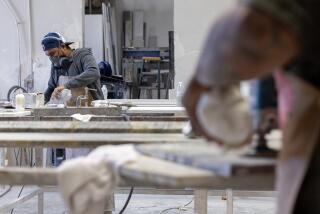Jewelry District Temblor
- Share via
The state crackdown on environmental and safety violations in one of the more than 30 high-rise buildings that make up Los Angeles’ downtown jewelry district hit the industry with the force of an earthquake. Fear that additional investigations could shut down manufacturing entirely and leave the bustling district a ghost town raced through the area. The reverberations reached as far as New York City, where the annual Jewelers of America trade show this week rocked with speculation that jewelry districts across the country would now face similar scrutiny.
But although a serious temblor, this was not the Big One. The state’s action is a warning to undertake the jewelry-industry equivalent of bolting down foundations. The good news is that the groundwork for doing so has already been laid.
The California Environmental Protection Agency, acting on a complaint from a tenant, ordered a halt to manufacturing in the Park Central Building at 412 W. 6th St. last month after finding hazardous levels of potentially cancer-causing heavy metals in air and dust samples.
Unless they read about the crackdown in The Times July 28, typical Angelenos may be unaware the city even has a jewelry district, much less the second-largest in the country. It’s an industry that doesn’t want to be noticed. Security is rigorous and trade secrets are guarded jealously. The Armenian, Persian, Latino and Chinese immigrants who make up the bulk of the district conduct business within their own closed networks.
The industry’s closed nature is part of the problem. There is little sharing of information about new techniques or materials that may be safer or better for workers and the environment.
So a year ago, officials in the Los Angeles Department of Building and Safety began meeting with jewelry district manufacturers and the Manufacturing Jewelers & Suppliers of America, a national trade association, to develop safety guidelines and education outreach on ventilation and the storage of toxic materials. All agree that the district’s cooperation has been unprecedented.
Rather than discouraging the efforts underway, the state’s action should serve as a wakeup call to jewelry companies that haven’t yet admitted how urgent and serious the safety situation is.
But now that it has the industry’s attention, the state needs to be part of the solution. It needs to work with the city to make sure the codes under consideration would bring the district up to state standards. These workplace problems can and should be fixed. There’s no better time to get that message across than immediately after a quake.
More to Read
Sign up for Essential California
The most important California stories and recommendations in your inbox every morning.
You may occasionally receive promotional content from the Los Angeles Times.










